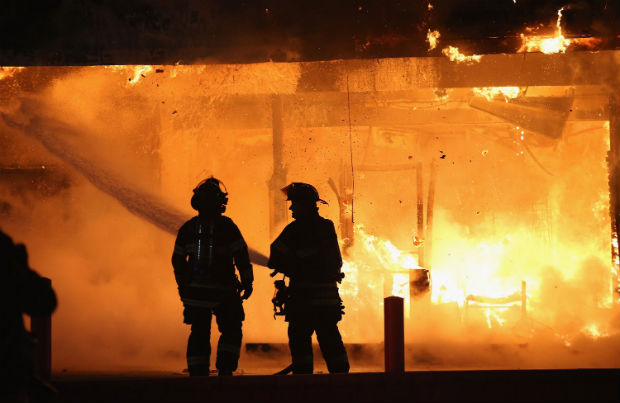
Firefighters try to extinguish a burning restaurant set on fire after protesters rioted following the grand jury announcement in the Michael Brown case on November 24, 2014 in Ferguson, Missouri. Ferguson has been struggling to return to normal after Brown, an 18-year-old black man, was killed by Darren Wilson, a white Ferguson police officer, on August 9. Scott Olson/Getty Images/AFP
FERGUSON, Missouri — Angry crowds poured into the streets of Ferguson within minutes of news that a grand jury decided not to indict a white police officer in the death an unarmed, black 18-year-old, whose fatal shooting sparked weeks of demonstrations and exposed deep racial tension between African-Americans and police.
President Barack Obama and the family of Michael Brown asked for calm after St. Louis County’s top prosecutor announced the grand jury’s decision Monday evening. As Obama spoke live from the White House briefing room, television networks showed Obama on one side of the screen, and violent demonstrations in Ferguson on the other.
Protesters overran a barricade and taunted police. Some chanted “murderer” and others threw rocks, shattered windows and vandalized cars. Several gunshots were also heard. Officers in armored vehicles lobbed canisters of irritants that made protesters’ eyes and lungs burn.
A grand jury of nine white and three black members decided not to indict Ferguson police officer Darren Wilson after weeks of deliberation. At least nine votes would have been required to indict Wilson.
Brown’s killing reignited a debate over how police treat young black men in the U.S. It drew attention to racial tensions simmering in Ferguson and other U.S. communities four decades after the civil rights movement of the 1960s.
The U.S. Justice Department is conducting a separate investigation into possible civil rights violations that could result in federal charges. The department also has launched a broad probe into the Ferguson Police Department, looking for patterns of discrimination.
St. Louis County Prosecutor Robert McCulloch announces the grand jury’s decision not to indict Ferguson police officer Darren Wilson in the Aug. 9 shooting of Michael Brown, an unarmed black 18-year old, on Monday, Nov. 24, 2014, at the Buzz Westfall Justice Center in Clayton, Mo. AP
The panel has been considering charges against Wilson, who fatally shot Brown after a confrontation on Aug. 9. The shooting inflamed tensions in the predominantly black St. Louis suburb that is patrolled by an overwhelmingly white police force. Rioting occurred the following night, protests erupted for weeks and police responded with armored vehicles and tear gas.
The tensions evoked other racially charged cases, including the riots that rocked Los Angeles in 1992 after the acquittal of white police officers in the videotaped beating of black motorist Rodney King. More recently, peaceful protests followed the 2013 not-guilty verdict in the Florida slaying in unarmed black teenager Trayvon Martin by George Zimmerman, who was not a police officer but coordinated the local neighborhood watch.
Missouri Gov. Jay Nixon traveled to St. Louis from the state Capitol and held a news conference ahead of the announcement, asking for “peace, respect and restraint.”
Authorities quickly stepped up security around the courthouse where the decision was announced. Barricades were erected, and more than 20 Missouri state troopers were seen silently assembling with rifles, 3-foot (0.91-meter) batons, riot shields and other equipment. Some nearby businesses boarded up their windows, just as many shops have already done near the site of Brown’s death in Ferguson.
Hours before the announcement, dozens of people gathered in the parking lot across the street from the Ferguson Police Department. Many stood right at the edge of the lot, almost in the street, chanting things “no justice, no peace, no racist police.”
One woman leading the group screamed through a bullhorn “indict that cop. Police don’t like it. We want an indictment.”
RELATED STORY
Federal autopsy ordered in Missouri teen’s death
Thousands march against police in St. Louis, 17 arrested
Originally posted: 10:47 AM | Tuesday, November 25th, 2014